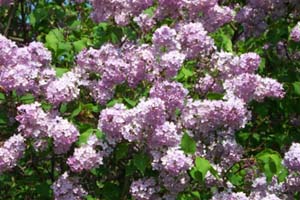Common Lilac
By: Avery Aamoth

The reason I chose this topic, is because I have always liked this particular flower. Coming from Montana, where it was always pretty common to see lilac bushes blooming in the spring and summer seasons. I was especially attracted to it's look, the strong fragrance it gives off, and how it seemed to symbolize the spring and summer months. I feel that the lilac has a strong psychological effect, and somehow always seem to brighten the mood after coming out of a cold winter.
About Lilacs
Did you know that there are over 1,000 varieties of lilacs in the world. They are arranged in many different colors such as: white, violet, lavender, pink, magenta and purple. They also vary in size from 4 to 8 foot plants to certain species that can grow to reach 30 feet in height. So you should be able to find the one that fits your needs.
The Common Lilac(Syringa vulgaris) bloom in the spring for only a brief 2 to 3 week period. To extend their presence, try growing a variety like early, mid and late bloomers. By doing this you may be able to see Lilacs in bloom for up to 6 weeks. Lilacs thrive in sunny areas with decent air circulation, and even though they can with stand extemely low temperatures, they need to be protected from cold winds that can actually kill the flower buds. Lilacs also cannot be planted in poorly drained areas where the roots can freeze during the winter. |
 |
The fragrance of Lilacs varies widely with species and cultivar. Even on the same plant, the fragrance depends upon the stage of bloom, time of day and temperature. The fragrance is strongest on warm, sunny afternoons when the florets are fully open. The amount of fragrance also depends on the cultivar. Small, dark, single florets usually are more fragrant than larger, lighter, double florets, but there can be exceptions.
History of the Lilac
Lilacs originated in Europe and Asia many years ago. In the United States, the Lilac dates back to the mid 1750's. They were grown in America's first botanical gardens and were very popular in New England.
Lilac bushes can survive for hundreds of years, so a bush planted back then may still be around.
The Lilac capital of the world is actually in Rochester, NY. Rochester is the scene of an annual, 2 week long Lilac festival, which contains over 500 species of Lilacs and more than 1200 Lilac bushes inside the park.

How to Grow
Lilacs are not difficult to grow, but they do have some basic requirements.
Lilacs are best grown in zones 3-7.
They don't require much water once they are established, and they prefer a sweet, well drained soil.
Prune them right after blooming.
You may want to use an ionized copper spray called Polydex once per month from May to September to prevent disease and bugs.
Lilacs can withstand dry conditions and extreme cold.
They like somewhat alkaline soils.
They can be planted in spring or fall.
Plant in well-drained sunny areas.
Feed with a general tree and shrub plant fertilizer right after blooming.
In the fall give the Lilac bush a cup of lime.
Source Information Sites
http://www.lilac-king.com/lkcare.htm
http://www.gardenersnet.com/lilac.htm
http://www.montana.edu/wwwpb/pubs/mt9805.html
http://gardening.about.com/library/prm/lilac/aa042502a.htm